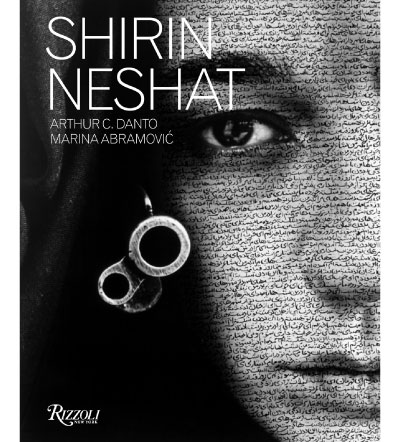
courtesy of Rizzoli Books USA

Shirin Neshat, the Iranian-American visual artist, has had an exiguous but rewarding career. Her body of work, mostly engaging the position of women vis-à-vis Islam, is scant but forceful. The new book, Shirin Neshat (Rizzoli, $75), is an ambitious effort to gather her art under one roof. The 272-page volume documents all of Neshat’s projects with photographs and stills from her videos and her first feature film, Women Without Men.
Neshat’s first undertaking, a series of photograph’s called The Women of Allah, remains her most poignant work. The photos depict Iranian women shrouded in veils and holding guns. Farsi poetry, including songs about martyrdom and sexual longing, is inscribed on their faces, hands, and feet. From Neshat, whose work is banned in Iran, one would expect a pointed critique of Islamist extremism, but the viewer doesn’t quite get that. The women don’t look like victims.
The rest of Neshat’s work is less ambivalent. The book is full of stills from her videos depicting separation of sexes and limitations of women’s personal freedom. The book culminates with stills from Women Without Men. The film deals with oppression of women in Iran. It is based on the eponymous novel by Shahrnush Parsipur, about four women who are betrayed by the society in which they live. The photos in the book succeed in freezing the characters’ complex emotions and revealing their suffering. These silent and abandoned women surely find a sympathetic voice in Neshat, whose work remains urgent and charged.
(more…)
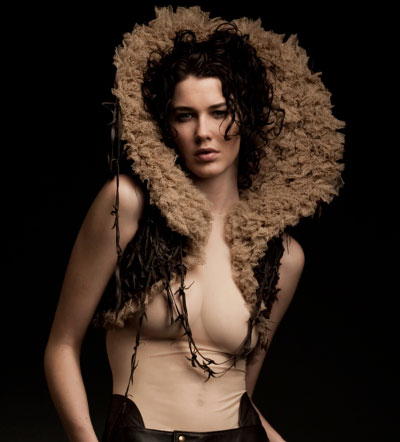
Photography by Diego Indraccolo, Model: Kirsten Varley, Styling: Kay Korsh

Rachel Freire missed her calling as a costume designer, but she fits right in with – or speeds ahead of – her aesthetic contemporaries, in both innovation and imagination. Freire graduated in 2006 from Central Saint Martins, where she studied Design for Performance rather than fashion design. She was “more interested in the psychological aspects of how people perceive dress”. Her latest collection for Fall/Winter 2010 particularly demonstrates her interest in testing limits and soliciting audience reaction. Freire, who labels her design aesthetic “Period drama meets Blade Runner”, excels in manufacturing futuristic beauty. Her sci-fi designs include jeweled headpieces; nude-colored, detailed bodysuits; and an oversize mirror-plated bolero that resembles a football player’s shoulder pads. Precise ruching, exaggerated ruffles, and minor elements of corsetry make Freire’s clothing veritable desserts made of silk and mirrorball pieces. Detailed but durable, the visionary’s conceptual looks are Gaga-ready, but still hint heavily at traditional influences and sophisticated techniques. Freire’s appropriate drama derives from theater, of course, and from her favorite designer, Thierry Mugler. Indeed she has a head start on filling the void that Mugler left when he stopped designing. Practically every item in this collection boasts an extravagance and depth that blur the line between clothing and accessory. Freire says she designs for “daring people, definitely…someone who wants to stand out.”
(more…)
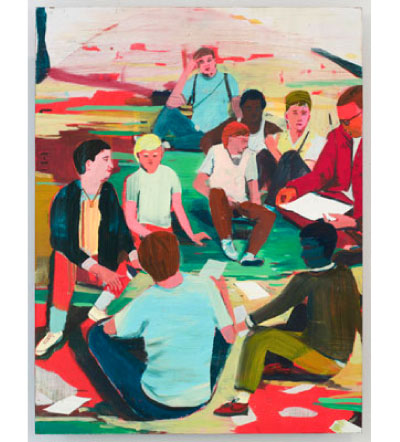
Jules de Balincourt, A Few Good Men, 2010. All images courtesy of Jules de Balincourt, A Few Good Men, 2010

If you’re searching for metaphysical rejuvenation, Jules de Balincourt mixes a potent visual tonic of apocalyptic sunbursts and fractured fortunetellers. Continuing his international successes in Paris, London, and Tokyo, the lithe 37-year-old graced Deitch’s cool gallery interiors last month with sixteen figurative and abstract paintings, marking his most extensive exhibition to date. Despite de Balincourt’s politically tinged oeuvre, his recent works have been decidedly more meditative, measuring the imprint of technology in a process of thoughtful internalization. Dense iterations of life, chaos, and computers, de Balincourt’s art presents content and form in a deliberate DIY, faux-naïf aesthetic. Oil and acrylic media, stencils, tape, knives, and spray paint are employed in equal measure.
Besides a penchant for lush settings and a Day-Glo palette, de Balincourt’s psychedelic-cum-futuristic art reveals his mélange of influences. Incorporating a French pedigree and California culture, it appears richly idiosyncratic (think a hallucinogenic hike through the Barbizon woods). Part humanitarian, part provocative, De Balincourt’s creative output could be seen to reflect his extracurricular activities, including the temporarily defunct Starr Space (a Brooklyn hub for yoga and gallery denizens alike) and Bush-era protests.
(more…)
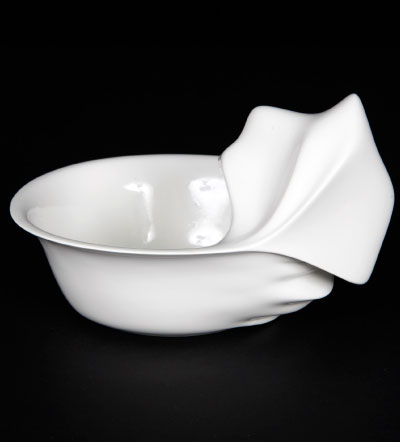
Photography and video courtesy of Geoffrey Mann

Geoffrey Mann of
Studio*Mrmann is an artist and designer who disintegrates the dividing line between art, craft, and design. His creations challenge our notions of the genres as he works to enlarge the gray area between them. Originally from and currently based in Edinburgh, UK, Mann received a postgraduate degree in Ceramics and Glass from the Royal College of Art, London after completing an undergraduate degree in 3D Design at Gray’s School of Art in Aberdeen. The integration of crafts, design, and multimedia demonstrated by Mann’s path as a student is also clear in his latest work,
Cross-fire — a unique project that seamlessly integrates a gorgeous work of animation with an unusual series of dishware and utensils.
Cross-fire animates a sound clip from American Beauty, the Oscar-winning film directed by Sam Mendes, in which the main character argues with his wife and daughter over the dinner table. In the clip, the voices of each character undulate through the plates, glasses, and utensils. As the emotions reach a crescendo, the waves of sound crash through the normally inanimate objects and deform “their once static existence into objects of unseen familiarity”, according to Mann’s description. Click through for the video.
(more…)

Photography courtesy of EMI

Everything about Massive Attack feels contradictory. The core members, Robert “3D” Del Naja and Grant “Daddy G” Marshall, are polar opposites. The former: diminutive, fair, pointy, reserved yet articulate. The latter: oversized, dark, rounded, affable yet hesitant. Not since the collective’s second album, 1994’s Protection, have these two made music in the same room.
Starting as a reggae sound system collective, the Wild Bunch, they represented an array of cultures, backgrounds, ethnicities, and traditions. This array drove the collective and gave birth to Massive Attack and the inimitable flavor it had — and has. “We were literally white straight through to black,” says Marshall amidst babysitting his three children in his Bristol, England, home as he placates them with a DVD of Up. “We spread from Italian culture through Spanish roots to Black culture. Coming from all walks of life, it was funny to have us all in one group.”
What has been heard since Protection — on albums like Mezzanine (1998), 100th Window (2003), and their latest Heglioland — is the individual members working on their own, then bringing their ideas to each other, ready for a face-off. More often than not, it is Del Naja’s vision that bullies itself to the forefront. On 100th Window — which should have been billed as Del Naja’s solo album — there was no input from Marshall, and erstwhile third member, Andrew “Mushroom” Vowles, who had since departed.
(more…)
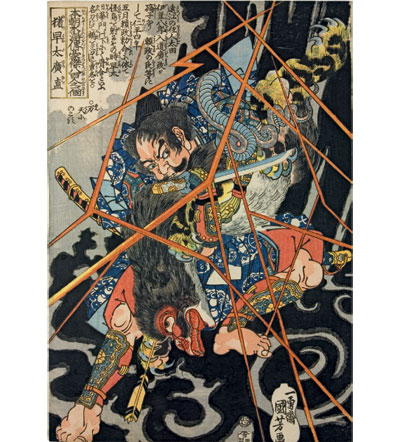
Mount Mongaku Does Penance in Nachi Waterfall, 1851. All artwork by Utagawa Kuniyoshi, All photography © Trustees of the British Museum. Courtesy of Japan Society. (Click Images to Enlarge)

From embattled warriors to writhing sea creatures, ukiyo-e aficionados and comic book collectors will find their niche in the fearsome and fantastic, now on display at the Japan Society through June 13. Showcasing exquisitely detailed woodblock prints by the godfather of modern video games and anime, Graphic Heroes, Magic Monsters: Japanese Prints by Utagawa Kuniyoshi (1797-1861), from the Arthur R. Miller Collection,” is a not-to-be-missed exhibition organized by Timothy Clark, head of the Japanese section of the British Museum. An action-packed show grouped in warrior, landscape, kabuki, beautiful women, and kyoga (literally “crazy pictures”) categories, the 130-print pictorama includes gems from the collection of NYU legal scholar Arthur R. Miller, rough sketches unearthed from the Victoria and Albert Museum and even onsite drawing by the mangaka-in-residence Hiroki Otsuka. Moved by the master printmaker, Otsuka will create a full-length comic strip as an interactive “meta-narrative” for exhibition goers.
Having created roughly 10,000 prints, Kuniyoshi can be viewed a powerful Pop Art progenitor who worked to satisfy the insatiable appetite of Edo period manga fan equivalents (at a rate of two soba platefuls per print, scholars estimate). But apart from his staggering output, the artist is celebrated for his spirited defiance and slew of creative tangents despite his censorial 1840s Tokugawa shogunate.
(more…)

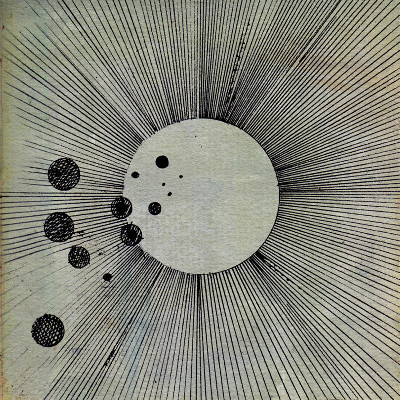
Warp Records

Flying Lotus’ commanding second album conjures alternate titles in my mind: “2010: A Space Oddity” or, perhaps more appropriate, “Sketches of Space”. Yet
Cosmogramma is quite fitting — a journey into an alternate musical universe, seemingly worlds beyond ours. It’s a giant leap forward for this LA-based producer; not that his debut wasn’t impressive, but as its name
Los Angeles connotes, he still had his feet firmly on local ground. Jet-pack strapped, FlyLo has taken along on his fantastic voyage a time capsule of jazz, funk, and psychedelics that leaks out across his electro blueprints. With its spastic, virtuoso bass line courtesy of Thundercat, “Pickled!” is the sound of droids dancing, while “Mmmhmm” is like an Outkast or Foreign Exchange track in orbit. “Computer Face/Pure Being” (stream below) is what Parliament-Funkadelic might be doing today if they were still making new music and using a Galaga machine as an instrument. Most promising is the showcase Flying Lotus creates for top musicians and vocalists including relative Ravi Coltrane on sax, harpist Rebekah Raff, and fellow cosmonaut Thom Yorke on guest vocals — it’s the deft trick Massive Attack and UNKLE employed to great strength when coming up, and it’s potent here. Most likely, the best electronic record you’ll hear all year and yet it’s so densely packed with multiple styles and layers, it could take through next year to fully decode its wonderful complexity.
Audio clip: Adobe Flash Player (version 9 or above) is required to play this audio clip. Download the latest version here. You also need to have JavaScript enabled in your browser.
Cosmogramma comes out May 4. Buy this at Other Music or iTunes.
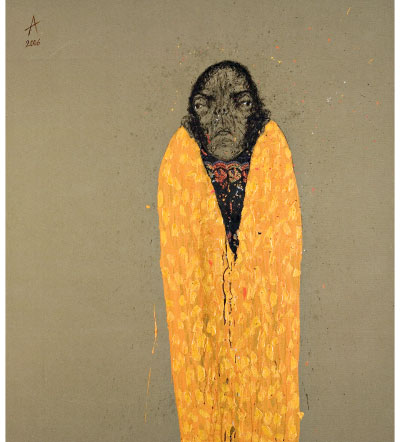
Sabhan Adam, Untitled (Figure in Yellow Coat), 2006, Private Collection, London

“It is a very exciting time for Middle Eastern artists: there is a real spirit of innovation and creativity in the air,” the famed architect Zaha Hadid, who is based in London but hails from Iraq, writes in the foreword to the newly released The Art of the Middle East.
Here’s a personal note just to put things in better perspective: When I began reporting on Middle Eastern arts and culture, some fifteen years ago, there were but a handful of notable players worth writing about — or so it seemed at the time. Now, as this book makes all too clear, not only are there enough artists to fill a hefty, 300-page coffee-table book but the number has swelled to the extent that such a compendium can’t make enough room for all of them. As thoroughly exclusive as The Art of the Middle East tries to be, several people — most notably the Hugo Boss Prize winning Palestinian artist Emily Jacir, who had her own retrospective at New York’s Guggenheim last Spring — have been left out. The author, Saeb Eigner, a British-Lebanese financier and self-assigned Arab arts champion (his credentials include acting as the senior adviser for the British Museum’s exhibition Word into Art: Artists of the Modern Middle East) apologizes for the omissions in the Afterword.
He’s forgiven. Especially since this book is so beautifully and impressively rendered.
(more…)
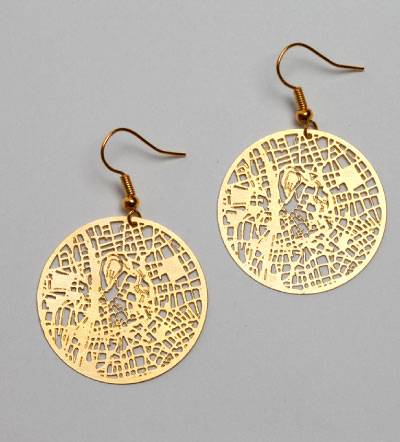

Physical places have an uncanny way of evoking nostalgia. Maybe it’s the street corner in New York where you first met your significant other or the club you went to practically every weekend that semester you studied in Berlin. It could be your childhood home, the campus of your alma mater or even that park in Copenhagen you spent one perfect day just lounging in—whatever the place or connection, our most visceral memories are inextricably linked to their locales.
Fluid Forms, an Austrian design firm, has come out with a design called Streets Earrings that allows anyone to adorn themselves with a satellite street map of any location in the world—a physical reminder of one’s best memory. In a process similar to developing photos, thin metal sheets are photo etched with satellite images of a location selected by the customer. The result is a delicately engraved satellite map, enclosed in a simple, dangling hoop.
Hannes Walter and Stephen Williams, co-founders of Fluid Forms, collaborated with New York-based urbanist and designer John Briscella to make the Streets designs. The series came after the firm’s initial line of custom products, which are all based on topographical maps of the Earth. “Realizing that our Earth concept often doesn’t work in large cities, which tend to be flat, we had been looking to something that would work well in cities for a while,” writes Williams vie e-mail. “Urbanism is becoming a trend, and since a lot of emotions are tied up to locations within cities, the streets concept became the perfect extension to the Earth concept.”
(more…)
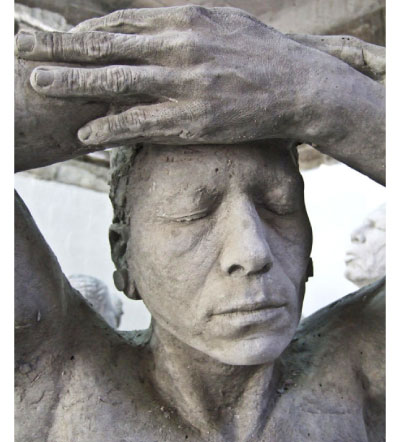
Photography courtesy of Jason deCaires Taylor

Underwater sculpture is an environmental art form invented by British diver and sculptor Jason deCaires Taylor, who is now hard at work creating more than 400 life-size sculptures that will form the world’s largest underwater sculpture museum. Located off of Cancun — Mexico’s largest tourist destination — the waters where the sculptures are located are visited by over 750,000 people each year.
Taylor’s sculptures are made of environmentally safe materials that encourage reef regrowth, and located on the ocean floor in areas that won’t harm existing ecosystems, thus allowing the much-damaged coral to regrow and create whole new ecosystems to support fish, crustaceans, and other invertebrates. The eery underwater presence of the life-size human sculptures involved in various activities (reading the paper; lounging in underwater gardens; maintaining an archive of messages in bottles) serves to distract the tourists, whose dives have thus far only worked to harm the Caribbean reefs, in order to prevent them from doing further damage.
(more…)





 Facebook
Facebook Permalink
Permalink Digg
Digg Reddit
Reddit LinkedIn
LinkedIn StumbleUpon
StumbleUpon Tumblr
Tumblr














